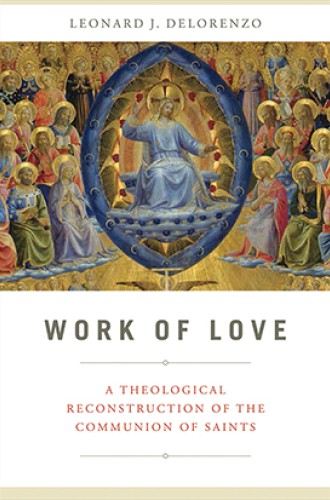Where are the dead?
Leonard DeLorenzo helps us envision where our loved ones have gone and how we relate to them.
This book is a difficult technical exposition of a doctrine that almost all Christians pay lip service to—it’s right there in the Apostles’ Creed—but that few of us think about. For Protestant readers, Work of Love is also a chance to experience the doctrine of the communion of saints in its Catholic fullness, to see how the veneration of one’s forebears in the faith might attest to and not distract from a robust belief in Christ’s Godhood.
Most of all, though, the book is a work of love because it teaches us how to think about our own dead—that ever-lengthening mental list of people who, in their friendship or antagonism or both, give us bits of ourselves, then leave. Like most moderns I have no idea what to do with my dead, or how to picture or conceive of them. Are they in heaven? Are they asleep, like the souls in George MacDonald’s Lilith? Are they scrambled like eggs, awaiting a Great Unscrambling? Or are they perhaps just dead?
According to DeLorenzo, my confusion can be traced to medieval changes in mourning and burial practices. Early Christians approached death as “a natural yet important part of life, which did not introduce . . . a rupture between the sick and the healthy, the individual and the society, or the dead and the living.” In any given ancient household, where life and death might be no more than a room away from each other, imagining the dead as part of one’s community wasn’t much of a stretch. DeLorenzo follows Philippe Ariès’s The Hour of Our Death closely here, and he offers close readings of Rilke and Heidegger to characterize the “individualizing, deafeningly silent thrust” of modern attitudes toward death.
DeLorenzo agrees with his post-Christian interlocutors that Christian theology must take death seriously and not seek to tame it. But this is not because, as Heidegger proclaims, death is a final truth of things. DeLorenzo writes:
Misconstruing the seriousness of death hinders the ability to appreciate the fullness of the gift that Christ embodies and confers in the Resurrection, which is precisely the gift that establishes and enlivens the communion of saints. . . . the full descent of the Word of God in the Incarnation goes to extreme limit of creation in the grave—into the state of being dead.
As Christians, we must give Christ credit for the full extent of his triumph over death.
DeLorenzo accomplishes a great deal in this book’s middle chapters by welcoming many voices to the conversation—Karl Rahner, Joseph Ratzinger, Hans Urs von Balthasar, N. T. Wright, Augustine, and others. But his main contribution is to make readers feel the size of the gap between God as creator and God as the creator’s dead child. He cleverly ties this account to the doctrine of the Trinity, encouraging us to imagine the entire drama of creation as taking place in the distance between the two Persons at this moment, which is also the moment that most fully reveals their oneness. Where are the dead? Well—somewhere between those two.
More specifically, they “dwell in the Lord,” which means “coming to move as the Lord moves in the descent of mercy.” DeLorenzo explains:
God’s mercy is his perception of suffering and action in response. Those who enjoy the beatific vision even now share in this glory, which means that they live in the movement of mercy that seeks to forge and complete the eschatological communion of all the saints. The intermediate state observes the social nature of salvation, guarding the truth that none of the blessed ceases desiring the healing of the whole body until all are joined together in communion.
Thus, the dead still exist within “the ongoing drama of history.” Here DeLorenzo adduces the testimony of Thérèse of Lisieux, who prayed on her deathbed that she not immediately enter heaven (whatever that may mean) but be allowed to continue building the kingdom until the work was done. Thérèse’s witness directly inspired Dorothy Day. And the gift continues. A living Christian is someone who waits, but waits actively, for the consummation of creation. Why should a dead Christian be any different?
I am not yet ready to offer—as DeLorenzo says we must—prayers to and for the dead, in the confidence that they pray reciprocally for my own needs and those of all the living. But this book allowed me to see this idea for the first time in all its beautiful coherence. It offered a forceful and welcome reminder of the social nature of salvation—that when I commune at God’s table every week, I am one with others across time. And it left me, as all talk of the amplitude of God’s promises leaves me, wondering where the boundaries are between the blessed and the excluded, and whether, in the fullness of time, God’s mercy must not go on erasing these boundaries—forever.
A version of this article appears in the August 16 print edition under the title “Where are the dead?”







